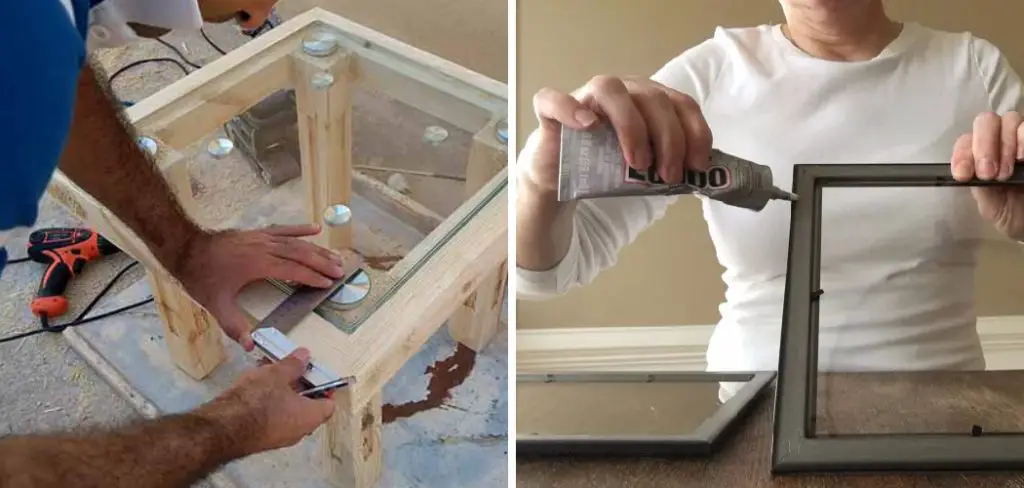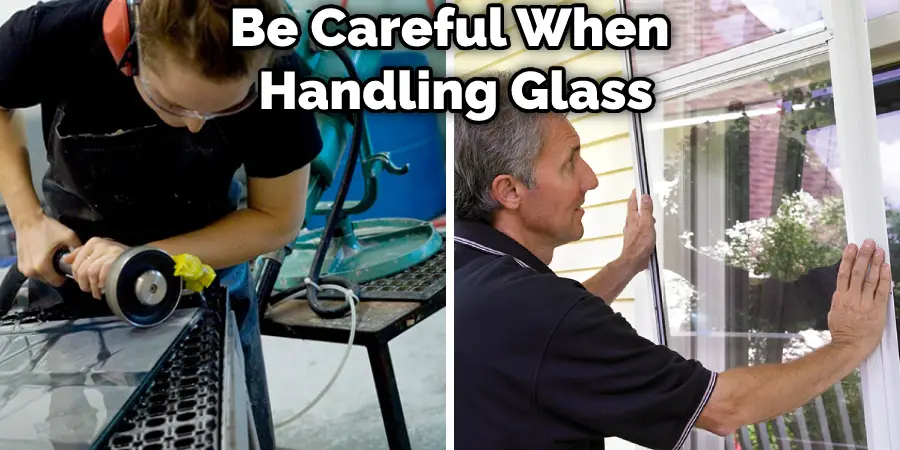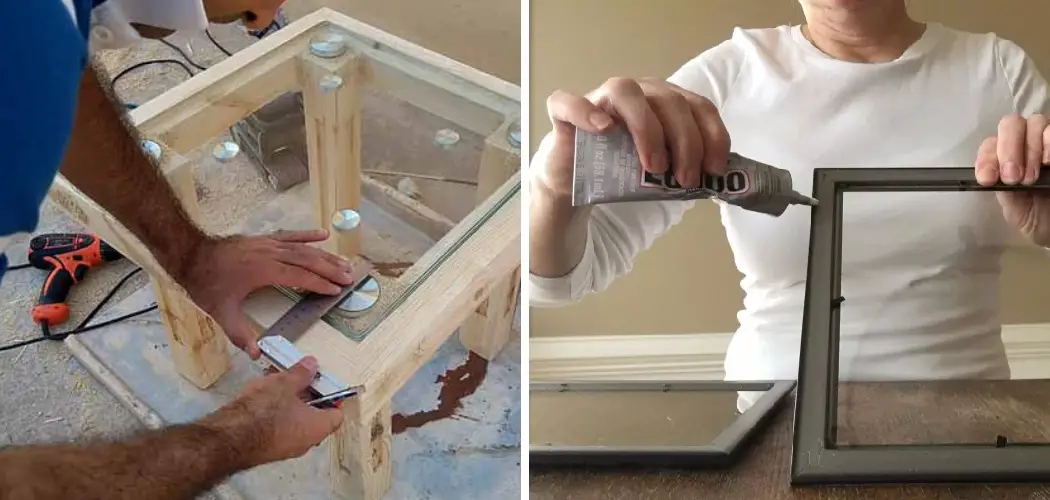Glass is an attractive addition to any frame, whether used as a window or as part of a picture frame. However, attaching glass to a wooden frame can be a challenge. If done correctly, though, the results will be worth the effort. Today, in this article, we’ll discuss how to attach glass to wood frame successfully. Keep reading to learn more.

Glasses are usually attached to the frame via clips or moldings. The former method is less time-consuming but may require regular adjustment. Moldings take more time to install but provide a neater, more finished look. Many people prefer to use moldings to give the frame a more polished appearance.
What Type of Glue Should Be Used to Attach Glass to Wood?
There are a few different types of glue that can be used to attach glass to wood. The best kind of glue to use will depend on the type of glass and wood you are working with, as well as the strength of the bond you need. Here are a few different options to consider:
– Epoxy: Epoxy is a strong and durable glue that can be used on porous and non-porous materials. It is ideal for attaching glass to wood because it creates a powerful bond. However, epoxy can be challenging to work with, and it takes longer to set than other types of glue.
– Super Glue: Superglue is a quick-drying glue that can be used on porous and non-porous materials. It is not as strong as epoxy, but it can be a good option if you need a quick fix.
– Hot Glue: Hot glue is a quick and easy way to attach glass to wood. It works best on non-porous materials such as glass, but it can also be used on porous materials such as wood. The downside of hot glue is that it is not as strong as other types of glue, and it can be challenging to control.
The best way to attach glass to wood will depend on the type of glass and wood you are working with, as well as the strength of the bond you need. If you need a strong adhesive, epoxy or super glue is your best option. Hot glue may be your best bet if you need a quick fix.
11 Detailed Guide on How to Attach Glass to Wood Frame:
Step 1: Gather All Necessary Materials
You’ll need the following materials to successfully attach glass to a wood frame:
Glass
The type of glass you use will depend on the purpose of your frame. If it is a picture frame, regular glass should suffice. However, if you are making a window frame, consider using tempered or laminated glass for added safety.
Wood Frame
Choose a high-quality wood frame that is sturdy and durable. Softwoods such as pine may not provide enough support for the glass. Hardwoods like oak or maple are better options.
Glue
As mentioned earlier, you can use epoxy, super glue, or hot glue to attach glass to wood. Choose the type of glue that best suits your needs and preferences.
Protective Equipment
Working with glass can be dangerous, so make sure you have protective equipment like gloves and goggles on hand. This will prevent any injuries from occurring.
Step 2: Clean the Surfaces
Before attaching the glass to the wood frame, make sure both surfaces are clean and free of any debris or dust. This will ensure a strong bond between the two materials. You can use a clean cloth and some alcohol to wipe down the surfaces. But be careful not to get any alcohol on the wood, as it can damage the finish. There are also specialized cleaners available for cleaning glass and wood surfaces.
Step 3: Measure and Cut the Glass
Measure the dimensions of your frame and cut the glass to fit accordingly. Be sure to leave a slight gap between the edges of the glass and the frame to prevent cracking or chipping. It’s always a good idea to cut the glass slightly larger than needed and then trim it down if necessary rather than cutting it too small. The glass can also be professionally cut to fit your frame if you are not comfortable doing it yourself.
Step 4: Apply Glue
Using a small amount of glue, apply it along the edges of the frame where the glass will be in contact. Be sure to use enough glue to create a strong bond but not too much that it seeps out and creates a mess. You can use a small brush or cotton swab to apply the glue for more precision. The type of glue you choose will determine how long it takes to set, so be sure to read the instructions carefully. It’s essential to work quickly but carefully during this step.
Step 5: Place the Glass
Carefully place the glass onto the frame, making sure it lines up with all edges and corners. Gently press down to ensure a secure bond between the glass and the frame. If any excess glue seeps out, wipe it away with a damp cloth before it dries. You can also use masking tape to secure the glass in place while the glue sets. It’s best to let the glue set for at least 24 hours before handling the frame. You can also place some heavy books on top of the glass to apply even pressure while it sets.

Step 6: Secure with Clips or Moldings
If using clips, carefully place them on each corner of the frame to hold the glass in place. If using moldings, apply a small amount of glue and gently press them into place along the edges of the frame. Be sure to use enough clips or moldings to keep the glass secure. The number you need will depend on the size of your frame. It’s always a good idea to let the glue set for another 24 hours before handling the frame again.
Step 7: Wipe Away Excess Glue
If any glue has seeped out from between the glass and frame, use a damp cloth to wipe it away before it dries. This will give your frame a clean and polished look. You can also use a razor blade to carefully scrape away any excess glue once it has dried. But be cautious not to scratch the glass or wood. You can also use a small amount of rubbing alcohol to remove any stubborn dried glue.
Thereafter, your glass should be successfully attached to the wood frame. If you follow these steps carefully and use a high-quality glue, your bond should be strong and durable. It’s always a good idea to periodically check the frame for any loose or weak areas and make repairs as needed.
Step 8: Let It Dry
The drying time will depend on the type of glue used. Be sure to follow the manufacturer’s instructions for drying times before handling the frame. Once it has dried, you can display your frame or use it for its intended purpose. You can also decorate the frame with paint, stain or other embellishments to match your decor. And that’s it! You now have a beautiful and securely attached glass frame ready to be used and admired. Remember always to handle glass frames** with care and caution to avoid any accidents or injuries.
Step 9: Add Finishing Touches
Once everything is dry, you can add any finishing touches to your frame, such as paint or varnish. If moldings are used, they can also be painted to match the frame or left natural for a rustic look. You can also add embellishments such as beads or ribbons for a personalized touch. Get creative and make your frame unique. It’s always a good idea to let any paint or varnish dry completely before handling the frame.
You now have a beautifully crafted glass and wood frame ready to display your favorite memories or add character to your home. Remember to always handle it with care and avoid placing the frame in direct sunlight to prevent any damage to the glass. Enjoy your new creation!
Step 10: Maintenance
To maintain the bond between the glass and wood, avoid exposing it to extreme temperatures and moisture. Also, be cautious when handling the frame to prevent any accidental damage. If the glass becomes loose or starts to crack, gently remove it and reapply glue as needed. With proper maintenance, your glass and wood frame should last for years to come. You can also periodically clean the frame with a mild glass cleaner and polish the wood with furniture wax to keep it looking like new.
Step 11: Enjoy Your New Glassed Wood Frame!
Now that your glass is securely attached to your wood frame, you can proudly display it and enjoy your beautiful creation. Remember to handle the frame with care and avoid placing it in areas where it may be susceptible to damage. With proper maintenance, your glassed wood frame will last for years to come.
These methods will help in how to attach glass to wood frame.
Do You Need to Use Professionals?
While these steps are easy to follow and can be done at home, it’s always best to consult with professionals if you have a valuable or irreplaceable piece of glass or wood. They will have the necessary skills and equipment to ensure a safe and successful attachment. Additionally, they can also offer advice on specialized glues or techniques for specific types of glass and wood. It may cost more, but it will give you peace of mind knowing your precious item is in capable hands. So, weigh the risks and consider consulting a professional if needed. In the end, it’s all about preserving cherished memories and creating beautiful displays with glass and wood frames.
How Much Could It Cost?
The cost of attaching glass to a wood frame will depend on the type and size of your frame, the quality of materials used, and whether or not you choose to consult a professional. If doing it yourself, materials such as glue, clips, or moldings can range from a few dollars to around $20. Professional services may cost more but can provide added expertise and assurance. Before starting your project, be sure to budget and research the costs of all necessary materials and services.
It’s always wise to compare prices from different sources and choose the best option for your needs and budget. With some patience, creativity, and careful handling, you can beautifully attach glass to a wood frame without breaking the bank. So go ahead and give it a try! Your future self will thank you for preserving those special memories in a stunning glass and wood frame.
Tips and Warnings:
Tips:
– Make sure the glass is clean before attaching it to the frame. Any dirt or debris on the surface of the glass will be visible once it is in place.
– If you are using a glue gun, be careful not to get any glue on the glass. This can be difficult to avoid, so you may want to use another method if you are concerned.
– It is best to attach the glass to the frame from the inside so that any imperfections are not as noticeable. If you must attach the glass from the outside, use a clear adhesive so that it is not as visible.
– Be sure that the frame is completely dry before attaching the glass. Any moisture on the surface of the frame will cause the adhesive not to adhere correctly.
Warnings:
– Be careful when handling glass. It can break easily and cause serious injury.
– Some adhesives can be toxic, so be sure to read the labels carefully before use.
– Wear gloves when working with adhesives to avoid getting them on your skin.

Frequently Asked Questions
Q1: Can Liquid Nails Be Used on Glass?
A1: Liquid Nails are a type of construction adhesive that can be used for bonding a variety of materials, including glass. While it can be applied to glass, there are a few things to consider. First, Liquid Nails should only be used on smooth, clean surfaces. Any dirt or debris will prevent the adhesive from properly bonding.
Second, it’s essential to apply a generous amount of adhesive to both surfaces that are being bonded. Third, the surfaces should be pressed firmly together and held until the adhesive sets. If done correctly, Liquid Nails can provide a strong bond between the glass and another surface. However, if not used properly, the bond may be weak or fail.
Q2: Will Gorilla Wood Glue Work on Glass?
A2: Gorilla Wood Glue is a reliable product that can be used for various projects. While it is not explicitly designed for use on glass, it can be used in a pinch. The key is to ensure that the surface is clean and dry before applying the glue. Once the glue has been applied, it will need to be held in place until it dries.
This typically takes 24 hours. In most cases, the bond will be strong enough to hold up to moderate use. However, it is essential to keep in mind that Gorilla Wood Glue is not designed for use on glass and should only be used as a temporary measure.
Q3: How Can I Remove Excess Glue or Adhesive From Glass?
A3: To remove excess glue or adhesive from glass, you can use a razor blade to carefully scrape it off. Be sure to hold the blade at an angle to avoid scratching the glass. Alternatively, you can also use rubbing alcohol or nail polish remover to dissolve and remove any remaining residue. It is essential to test these solutions on a small, inconspicuous area of the glass before using them on a larger surface. Additionally, be sure to wear protective gloves and work in a well-ventilated area when using these chemicals.
Q4: Can I Use Epoxy Glue to Attach Glass to Wood?
A4: Yes, epoxy glue can be used to attach glass to wood. However, it is important to note that not all epoxies are suitable for use on glass. It is best to choose an epoxy specifically designed to bond glass and wood together. As with any adhesive, be sure to thoroughly clean and dry both surfaces before applying the epoxy.
Follow the manufacturer’s instructions for mixing and application, and hold the glass in place until the epoxy sets. Once cured, epoxy provides a strong bond that can withstand regular use.
Conclusion:
So there you have it, how to attach glass to wood frame! Your very own step-by-step guide on attaching glass to a wood frame. We hope you found this post helpful and that you will be able to complete your project with ease. If you have any questions or run into any problems, feel free to comment below, and we will do our best to help out. Happy framing!
You May Also Read: How to Paint Cardboard to Look Like Wood

